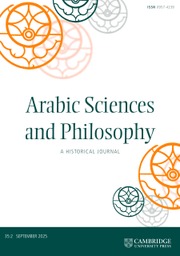Article contents
AVICENNA'S THEORY OF PRIMARY MIXTURE
Published online by Cambridge University Press: 01 March 2008
Abstract
Ancient Peripatetics and Neoplatonists had great difficulty coming up with a consistent, interpretatively reasonable, and empirically adequate Aristotelian theory of complete mixture or complexion. I explain some of the main problems, with special attention to authors with whom Avicenna was familiar. I then show how Avicenna used a new doctrine of the occultness of substantial form (whose roots are found in Alfarabi) to address these problems. The result was in some respects an improvement, but it also gave rise to a new set of problems, which were later to prove fateful in the history of early modern philosophy.
- Type
- Research Article
- Information
- Copyright
- Copyright © Cambridge University Press 2008
- 25
- Cited by


